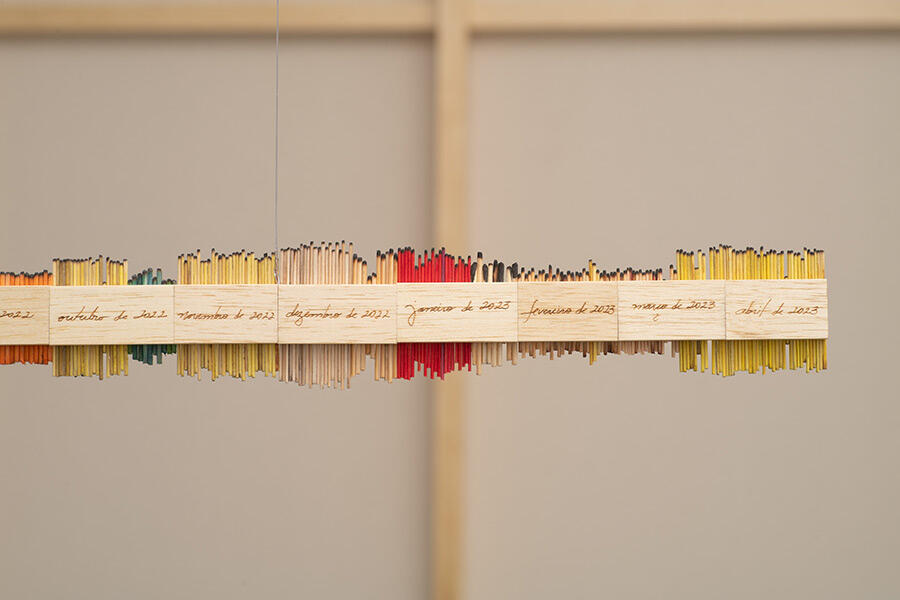Thiago Honório’s Procession Through Brazil’s History
At Galeria Luisa Strina, São Paulo, the artist recontextualizes artifacts from the country’s colonial and religious past
At Galeria Luisa Strina, São Paulo, the artist recontextualizes artifacts from the country’s colonial and religious past

Two hazel-coloured crystal eyes in cedar sockets peer out from a white wall. They stare out of the gallery’s reception area, devoid of a body. Greeting visitors to Thiago Honório’s exhibition ‘Oração’ at Galeria Luisa Strina in São Paulo, Vista (2020–23) sets an intriguing tone for the show. In Portuguese, vista means both ‘view’ and ‘wear’, while oração refers to both ‘prayer’ and ‘grammatical clause’. Honório’s titular wordplay prompts questions about the complex relationships between time, space and matter as well as our human struggle to reconcile the sensorial and the intellectual.

The gallery’s U-shaped layout establishes a processional progression through the exhibition. Moving into the main space we encounter the installation Texto (Text, 2020–23), which feels like we have stumbled across a cortège en route to the church. The work comprises a 17th-century, wooden, human-sized religious figure standing amidst branches of cotton arranged in a metal grid to form a small field. With her back to the entrance, she faces a floor-to-ceiling, raw-cotton screen. Known generically in Portuguese as roca, these wooden effigies are carried during religious processions and, although this one is bare, they are commonly dressed in cotton outfits – hence their name, which derives from the Portuguese for spinning wheel. Here, by formally linking the roca to the cotton field, Honório speaks to Brazil’s colonial past and to the systems of control (slavery and religion) that shaped much of its social culture. The installation’s title references Roland Barthes’s The Pleasure of the Text (1973), in which the French scholar writes that ‘text means tissue’ (or fabric). Rather than understanding texts as static products, Barthes maintains they are ‘worked out in a perpetual interweaving’ according to their context. This open-ended notion of a product/text/object permeates Honório’s show, in which the works continually invite new meanings.

Behind the large cotton screen hangs Oração (2018–23), a long horizontal structure composed of differently sized and coloured tips of incense sticks that the artist burned daily over a five-year span. Grouped by month and year and pyrographed onto wooden plaques, the work reads as a physical inscription: a non-verbal text that reminds the viewer of the artist’s ritual burning, thereby linking the title’s religious and grammatical meanings.

In two interconnected office spaces, Leituras (Readings, 2023) and Corte (Cut, 2020–23) close the exhibition. The former is a pair of sculpted hands: replicas of an 18th-century work by Brazilian colonial artist Antônio Francisco Lisboa, whose purportedly deformed hands (of which there is little historical evidence) led to him being known as Aleijadinho or ‘little cripple’. In Leituras, the sculpted hands lie on one of two exhibited copies of Brazilian poet Mário de Andrade’s modernist book O Aleijadinho e Álvares de Azevedo (Aleijadinho and Álvares de Azevedo, 1935). By referencing Aleijadinho – who sculpted numerous religious figures despite his mythical physical limitations – Honório acknowledges the role of storytelling in weaving socio-cultural histories, interpreting artworks and their makers, and creating and disseminating meaning. The work is complemented by public readings of the text during the show’s run. Concluding the procession is Corte: a 19th-century roca head piked onto a hollow, stainless-steel cube, through which other artists’ works can be seen hanging on the gallery’s storage frame. Honório’s successful coupling of artisanal and industrial object-making alludes to the power of framing knowledge and art-display systems and, in the context of a gallery, to the role of markets within which society and its by-products exist and operate.
Thiago Honório’s ‘Oração’ is on view at Galeria Luisa Strina, São Paulo, until 24 June.
Main Image: Thiago Honório, Texto (Text) (detail), 2020–23, 17th century religious image, cotton branches collected during the 2022 winter and stainless steel, 1.7 × 7 m. Photograph: Edouard Fraipont; courtesy: Galeria Luisa Strina, São Paulo
























